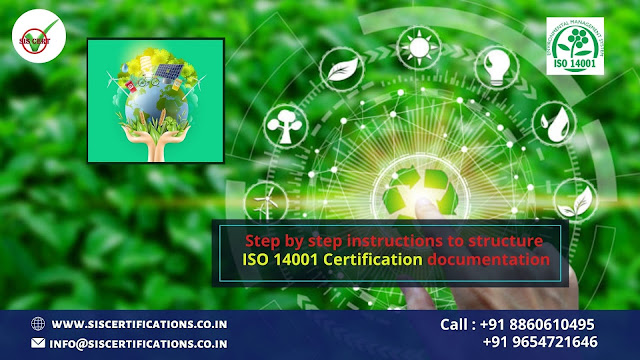Step by step instructions to structure ISO 14001 Certification documentation
Improvement of the documentation and record control framework for your ISO 14001 Certification -based EMS (Environmental Management System) is a significant aspect of the usage, since it will characterize the technique for creation, distributing, withdrawal, and utilization of your archives and records. It is dependent upon the association to make the most reasonable documentation, since it will influence the manner in which you keep up and improve your EMS. It tends to be a weight that will make your EMS harder to keep up, and hence become only a convention, or it can encourage the support and empower the organization to yield the advantages of ISO 14001 Certification implementation.
Which
document is more significant?
Prior to beginning to create EMS
documentation, it is essential to get an away from of the reason for each kind
of report, and where it has a place in the documentation chain of importance.
There are a few sorts of reports used to build up an EMS: strategy, targets,
manual, methods, work directions, rules or SOPs (Standard Operating
Procedures), and records and structures. Each sort of archive and record has
its place and function in the EMS,as represented below:
Toward the start of the usage and creating of the documentation, individuals are frequently befuddled on which archive is the most significant and what record precedes another. The least difficult approach to decide the order is to see who composes the archive, who is it for, and what is its purpose. On the off chance that the record is composed by the top administration, at that point it goes on the top; in the event that it is filled in by the representatives, it goes on the lower part of the pyramid.
The most effective method to structure your ISO 14001 Certification EMS documentation
The facts
confirm that the global standard for Environmental Management Systems (ISO14001:2015) requires certain documentation (see this article: List of
obligatory records needed by ISO 14001:2015). The reason and the advantages of
the EMS documentation are complex: it gives an away from of the tasks in an
association, it permits consistency of cycles and better comprehension of the
EMS, and it gives proof to accomplishment of destinations and objectives. When
planning EMS documentation, you should zero in on proficiency and make cycles
and reports that are relevant in your association. The most ideal approach to
begin delivering the reports is to comprehend their job and reason before
making and upholding them. The documentation for an Environmental Management
System ought to be organized as follows:
(1) EMS Policy : A strategy speaks to a declarative statement by
an association – something like a constitution of the system – and all
different records emerge from it. The approach is composed by the top
administration and its motivation is to characterize the overall bearing and
point of the EMS. The Environmental Policy additionally gives a structure to
building up EMS Objectives. For more data about the EMS Policy, see: How to
compose an ISO 14001 Certification policy.
2) EMS Manual: In spite
of the fact that it's anything but an obligatory record as per ISO 14001Certification, it is regularly used to report the extent of the EMS and the
principle components of the EMS and their communication, and reference to
related archives. Since it is a typical report, it is generally the main
archive that the Certification body needs to see to get acquainted with the
framework. In situations where it is a little organization or an organization
with basic perils, everything techniques can be set into an EMS Manual.
3) Procedures: EMS
methods can have various organizations and structures. They can be account,
i.e., portrayed through content; they can be more organized by utilizing
tables; they can be more illustrative, i.e., stream diagrams; or they can be
any blend of the abovementioned. Techniques ought to incorporate title, reason,
extension, duties and specialists, depiction of exercises, and reference to
pertinent work directions, SOPs, and records.
4) Work directions, rules, and SOPs : The fundamental motivation behind work directions is to dodge individualities by clarifying precisely how a specific action is done. It is typically composed for the exercises inside the cycle with the most noteworthy odds of dissentions happening, or for complex or once in a while directed exercises. Work directions can be important for a methodology, or they can be referred to in a strategy. By and large, work directions have a comparable structure to the methodology and spread similar components; nonetheless, the work guidelines incorporate subtleties of exercises that should be acknowledged, zeroing in on the sequencing of the means, apparatuses, and techniques to be utilized and required accuracy.
5)
Records and structures: At
long last, there must be some proof that exercises and process are led in the
manner endorsed in the methodology and work guidelines. This is the principle
motivation behind the records and structures. The greater part of them are
filled in by workers, however some of them (e.g., Management Review Minutes)
are filled in by the top administration. The most ideal approach to make them
reasonable is to abstain from expecting workers to compose articles. Having
records with checkboxes rather than void columns for representatives to set up
sentences will guarantee that the structures or accounts are filled in rapidly
and without any problem.
RRelated Article :
What is ISO 9001 Certification ?
How to Apply ISO 14001 Certification in Taiwan?
What is benefits of ISO 22000 Certification (FSMS) ?
What is advantage of ISO 27001 Certification in bank and other small size company?
What is ISO 37001 Certification?
What is benefits of ISO 13485 Certification in medical Industries?
Trend Article : -
1- How can i get ISO 22000 Certification for food supply business?
2 - How does ISO 45001 Certification support worker heath and safety?
3 - What is ISO 14001 Certification (EMS) ? how can i apply for this ISO standard?












Comments
Post a Comment